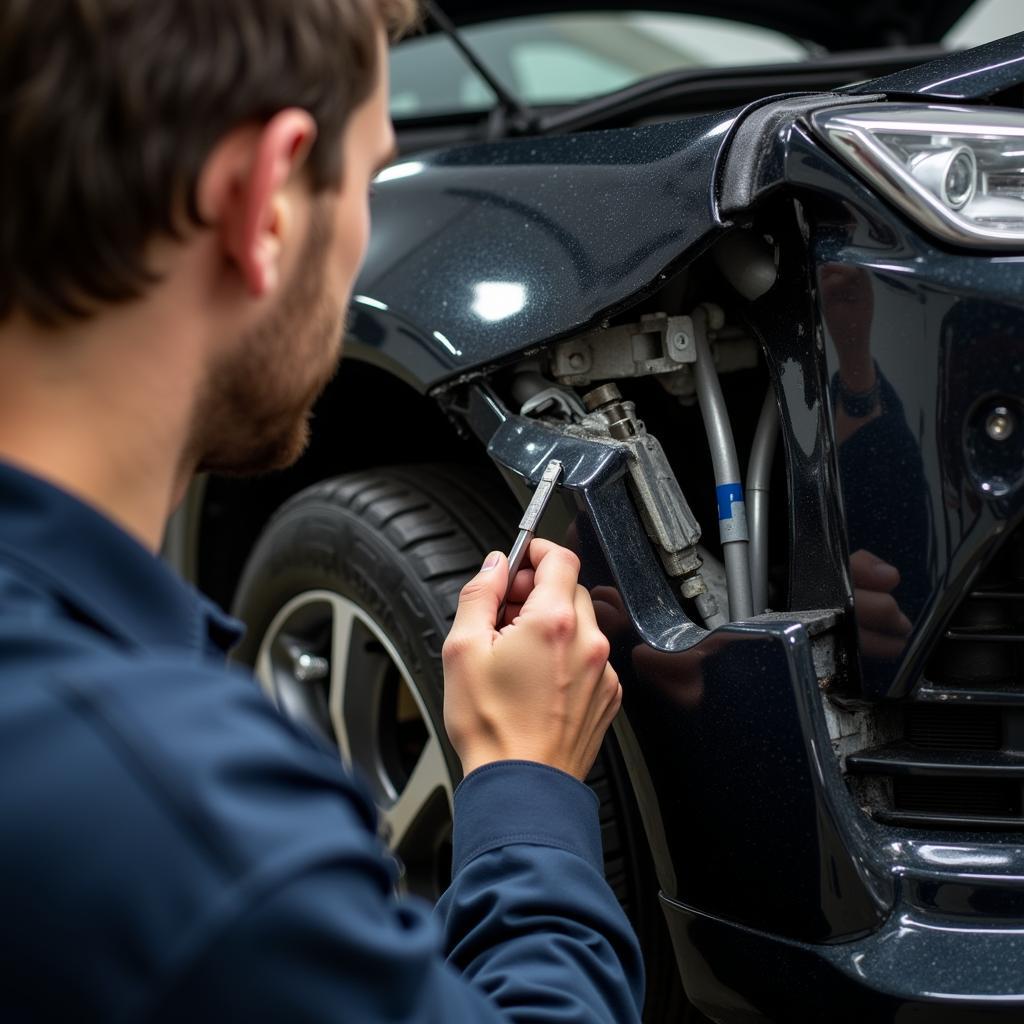Fixing major damage on a car can be a daunting task, whether you’re a car owner, a mechanic, or an automotive technician. From assessing the extent of the damage to choosing the right repair strategy, this guide will provide you with valuable insights and practical advice to navigate the complexities of major car repairs. We’ll cover everything from bodywork to mechanical issues, offering tips and tricks to ensure a successful and cost-effective repair process. fixing scratched up car rim
Understanding the Scope of the Damage
Before embarking on any repair, a thorough assessment of the damage is crucial. This involves identifying all affected parts, determining the severity of the damage, and understanding the underlying cause. This step is essential for accurate cost estimation and effective repair planning. For instance, a seemingly minor fender bender could have hidden damage to the frame, requiring more extensive repairs than initially anticipated.
Identifying the Affected Areas
Start by visually inspecting the damaged areas. Look for dents, scratches, cracks, and any signs of misalignment. Check for underlying damage by examining the surrounding components and looking for signs of stress or deformation.
Determining the Severity
Categorize the damage as minor, moderate, or severe. Minor damage usually involves cosmetic issues like scratches or small dents. Moderate damage might include deeper dents, cracked bumpers, or damaged headlights. Severe damage typically involves structural damage to the frame, extensive bodywork, or major mechanical issues. Remember, accurately assessing the severity is crucial for determining the appropriate repair strategy and estimating the cost effectively.
Choosing the Right Repair Strategy: DIY vs. Professional
Once you’ve assessed the damage, you need to decide whether to tackle the repairs yourself or seek professional help. Minor damage, like fixing a scratched up car rim might be manageable with DIY solutions, but major damage often requires specialized tools, expertise, and experience that only a professional can provide.
 Assessing Major Car Damage
Assessing Major Car Damage
DIY Repairs: When and How
DIY repairs are suitable for minor cosmetic issues or simple mechanical tasks. For example, how to fix broken water hose in car can be handled by a car owner with basic mechanical skills. However, for anything beyond basic repairs, it’s best to consult a professional. Attempting complex repairs without proper knowledge and tools can lead to further damage and increased costs in the long run.
Professional Repairs: Finding the Right Expert
For major damage, finding a reputable and experienced auto repair shop is crucial. Look for certifications, positive reviews, and a proven track record. Don’t hesitate to ask for quotes from multiple shops to compare prices and services. A good mechanic will explain the repair process in detail and answer all your questions. “Choosing the right repair shop can be the difference between a successful repair and a recurring nightmare,” says John Miller, a veteran automotive technician with over 20 years of experience.
Repairing Major Body Damage
Fixing major body damage often involves panel replacement, frame straightening, and extensive bodywork. These procedures require specialized tools and expertise.
Frame Straightening
Frame damage can compromise the structural integrity of the vehicle, affecting its handling and safety. Frame straightening involves using hydraulic equipment to restore the frame to its original shape. This is a complex procedure that should only be performed by qualified professionals.
Panel Replacement
Damaged panels, such as fenders, doors, or hoods, often need to be replaced. This involves removing the damaged panel, welding in a new one, and ensuring a seamless fit.
Mechanical Repairs after Major Damage
Major accidents can also cause significant mechanical damage. This might include engine damage, transmission problems, or suspension issues.
Engine and Transmission Repairs
Engine and transmission repairs are among the most complex and expensive car repairs. how much does it cost to fix a car radiator provides insights into the cost of a common cooling system repair, highlighting the potential expenses associated with more complex mechanical issues. These repairs often require specialized diagnostic equipment and extensive mechanical knowledge. “Addressing mechanical issues promptly is crucial to prevent further damage and ensure the longevity of your vehicle,” emphasizes Sarah Johnson, a certified automotive engineer.
Suspension and Steering System Repairs
Damage to the suspension or steering system can significantly impact the vehicle’s handling and safety. These repairs might involve replacing damaged components, such as control arms, tie rods, or shock absorbers.
Cost Considerations and Insurance Claims
Fixing major damage on a car can be expensive. Understanding the cost factors and navigating insurance claims is crucial. fixing ripped leather car seat shows how even seemingly small repairs can add up, emphasizing the importance of accurate cost estimation.
Estimating Repair Costs
Obtain detailed quotes from multiple repair shops before making a decision. Consider the cost of parts, labor, and any additional services. “Getting multiple quotes allows you to compare prices and ensures you’re getting a fair deal,” advises John Miller.
Navigating Insurance Claims
If the damage is covered by insurance, contact your insurance company as soon as possible. Provide them with all necessary documentation, including police reports, photos of the damage, and repair estimates. how much will it cost to fix a totaled car provides valuable information about dealing with totaled cars and insurance claims. Understanding your policy and working closely with your insurance adjuster can help streamline the claims process.
Conclusion
Fixing major damage on a car requires careful planning, informed decision-making, and often, the expertise of qualified professionals. From assessing the damage to choosing the right repair strategy, understanding the process is crucial for a successful and cost-effective repair. Remember to prioritize safety and seek professional help when needed. Contact AutoTipPro at +1 (641) 206-8880 or visit our office at 500 N St Mary’s St, San Antonio, TX 78205, United States for any assistance with your car repair needs. We’re here to help you get back on the road safely.




Leave a Reply